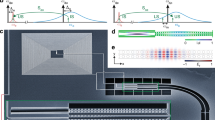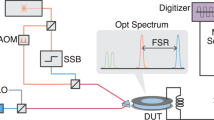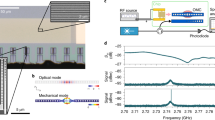Abstract
Microwave-to-optics transduction is emerging as a vital technology for scaling quantum computers and quantum networks. To establish useful entanglement links between qubit processing units, several key conditions must be simultaneously met: the transducer must add less than a single quantum of input-referred noise and operate with high efficiency, as well as large bandwidth and high repetition rate. Here we present a design for an integrated transducer based on a planar superconducting resonator coupled to a silicon photonic cavity through a mechanical oscillator made of lithium niobate on silicon. We experimentally demonstrate its performance with a transduction efficiency of 0.9% with 1 μW of continuous optical power and a spectral bandwidth of 14.8 MHz. With short optical pulses, we measure the added noise that is limited to a few photons, with a repetition rate of up to 100 kHz. Our device directly couples to a 50 Ω transmission line and can be scaled to a large number of transducers on a single chip, laying the foundations for distributed quantum computing.
This is a preview of subscription content, access via your institution
Access options
Access Nature and 54 other Nature Portfolio journals
Get Nature+, our best-value online-access subscription
$29.99 / 30 days
cancel any time
Subscribe to this journal
Receive 12 print issues and online access
$259.00 per year
only $21.58 per issue
Buy this article
- Purchase on Springer Link
- Instant access to full article PDF
Prices may be subject to local taxes which are calculated during checkout




Similar content being viewed by others
Data availability
Source data for the figures are available via Zenodo at https://doi.org/10.5281/zenodo.8232627.
References
Kimble, H. J. The quantum internet. Nature 453, 1023 (2008).
Wehner, S., Elkouss, D. & Hanson, R. Quantum internet: a vision for the road ahead. Science 362, eaam9288 (2018).
Alexeev, Y. et al. Quantum computer systems for scientific discovery. PRX Quantum 2, 017001 (2021).
Ladd, T. D. et al. Quantum computers. Nature 464, 45 (2010).
de Leon, N. P. et al. Materials challenges and opportunities for quantum computing hardware. Science 372, eabb2823 (2021).
Gambetta, J. IBM Research Blog https://research.ibm.com/blog/next-wave-quantum-centric-supercomputing (2022).
Awschalom, D. et al. Development of quantum interconnects (QuICs) for next-generation information technologies. PRX Quantum 2, 017002 (2021).
Krastanov, S. et al. Optically-heralded entanglement of superconducting systems in quantum networks. Phys. Rev. Lett. 127, 040503 (2021).
Bravyi, S., Dial, O., Gambetta, J. M., Gil, D. & Nazario, Z. The future of quantum computing with superconducting qubits. J. Appl. Phys. 132, 160902 (2022).
Magnard, P. et al. Microwave quantum link between superconducting circuits housed in spatially separated cryogenic systems. Phys. Rev. Lett. 125, 260502 (2020).
McKenna, T. P. et al. Cryogenic microwave-to-optical conversion using a triply resonant lithium-niobate-on-sapphire transducer. Optica 7, 1737 (2020).
Xu, Y. et al. Bidirectional interconversion of microwave and light with thin-film lithium niobate. Nat. Commun. 12, 4453 (2021).
Sahu, R. et al. Quantum-enabled operation of a microwave-optical interface. Nat. Commun. 13, 1276 (2022).
Vainsencher, A., Satzinger, K. J., Peairs, G. A. & Cleland, A. N. Bi-directional conversion between microwave and optical frequencies in a piezoelectric optomechanical device. Appl. Phys. Lett. 109, 033107 (2016).
Jiang, W. et al. Efficient bidirectional piezo-optomechanical transduction between microwave and optical frequency. Nat. Commun. 11, 1166 (2020).
Mirhosseini, M., Sipahigil, A., Kalaee, M. & Painter, O. Superconducting qubit to optical photon transduction. Nature 588, 599 (2020).
Stockill, R. et al. Ultra-low-noise microwave to optics conversion in gallium phosphide. Nat. Commun. 13, 2496 (2022).
Higginbotham, A. P. et al. Electro-optic correlations improve an efficient mechanical converter. Nat. Phys. 14, 1038 (2018).
Arnold, G. et al. Converting microwave and telecom photons with a silicon photonic nanomechanical interface. Nat. Commun. 11, 4460 (2020).
Han, J. et al. Coherent microwave-to-optical conversion via six-wave mixing in Rydberg atoms. Phys. Rev. Lett. 120, 093201 (2018).
Fernandez-Gonzalvo, X., Horvath, S. P., Chen, Y. H. & Longdell, J. J. Cavity-enhanced Raman heterodyne spectroscopy in Er3+:Y2SiO5 for microwave to optical signal conversion. Phys. Rev. A 100, 033807 (2019).
Bartholomew, J. G. et al. On-chip coherent microwave-to-optical transduction mediated by ytterbium in YVO4. Nat. Commun. 11, 3266 (2020).
Hisatomi, R. et al. Bidirectional conversion between microwave and light via ferromagnetic magnons. Phys. Rev. B 93, 174427 (2016).
Lauk, N. et al. Perspectives on quantum transduction. Quantum Sci. Technol. 5, 20501 (2020).
Han, X., Fu, W., Zou, C.-L., Jiang, L. & Tang, H. X. Microwave-optical quantum frequency conversion. Optica 8, 1050 (2021).
Siddiqi, I. Engineering high-coherence superconducting qubits. Nat. Rev. Mat. 10, 875 (2021).
Krinner, S. et al. Realizing repeated quantum error correction in a distance-three surface code. Nature 605, 669 (2022).
Horsman, C., Fowler, A., Devitt, S. & van Meter, R. Surface code quantum computing by lattice surgery. New J. Phys. 14, 123011 (2012).
Beals, R. et al. Efficient distributed quantum computing. Proc. R. Soc. A 469, 20120686 (2013).
Krinner, S. et al. Engineering cryogenic setups for 100-qubit scale superconducting circuit systems. EPJ Quantum Technol. 6, 2 (2019).
Zeuthen, E., Schliesser, A., Sørensen, A. S. & Taylor, J. M. Figures of merit for quantum transducers. Quantum Sci. Technol. 5, 34009 (2020).
Brubaker, B. M. et al. Optomechanical ground-state cooling in a continuous and efficient electro-optic transducer. Phys. Rev. X 12, 021062 (2022).
Jiang, W. et al. Optically heralded microwave photon addition. Nat. Phys. https://doi.org/10.1038/s41567-023-02129-w (2023).
Chan, J., Safavi-Naeini, A. H., Hill, J. T., Meenehan, S. & Painter, O. Optimized optomechanical crystal cavity with acoustic radiation shield. Appl. Phys. Lett. 101, 081115 (2012).
Aspelmeyer, M., Kippenberg, T. J. & Marquardt, F. Cavity optomechanics. Rev. Mod. Phys. 86, 1391 (2014).
Xu, M., Han, X., Fu, W., Zou, C.-L. & Tang, H. X. Frequency-tunable high-Q superconducting resonators via wireless control of nonlinear kinetic inductance. Appl. Phys. Lett. 114, 192601 (2019).
Kuwictsova, I. E., Zaitsev, B. D., Joshi, S. G. & Borodina, I. A. Investigation of acoustic waves in thin plates of lithium niobate and lithium tantalate. IEEE Trans. Ultrason., Ferroelectr., Freq. Control 48, 322 (2001).
Riedinger, R. et al. Non-classical correlations between single photons and phonons from a mechanical oscillator. Nature 530, 313 (2016).
Qiu, L., Shomroni, I., Seidler, P. & Kippenberg, T. J. Laser cooling of a nanomechanical oscillator to its zero-point energy. Phys. Rev. Lett. 124, 173601 (2020).
Lecocq, F. et al. Control and readout of a superconducting qubit using a photonic link. Nature 591, 575 (2021).
Delaney, R. D. et al. Superconducting-qubit readout via low-backaction electro-optic transduction. Nature 606, 489 (2022).
Acknowledgements
We would like to thank A. Safavi-Naeini for valuable discussions and support. We thank J. van Oven and D. de Jong at Qblox for technical support. We further gratefully acknowledge assistance from E. He, helpful discussions with C. Jurczak and J. Fink, supply of wafers from NGK Insulators and the hospitality of the Department of Quantum Nanoscience at Delft University of Technology and the Kavli Nanolab Delft. This work is financially supported by the European Innovation Council (EIC Accelerator QModem 190109269) and the Province of Zuid-Holland (R&D samenwerkingsproject QConnect).
Author information
Authors and Affiliations
Contributions
All authors contributed to the simulation, fabrication and testing of the device. P.D., S.S. and M.L. fabricated the device. M.J.W., A.C.B., R.S., B.H., T.C.v.T. and F.H. performed the experiments described in the manuscript. B.H., S.S. and R.S. simulated the device performance. M.J.W., R.S., S.G., A.C.B. and B.H. wrote the manuscript with input and editing from all authors.
Corresponding authors
Ethics declarations
Competing interests
All authors are or have been employed by QphoX B.V. and are, have been, or may in the future be participants in incentive stock plans at QphoX B.V. The authors declare that they have no competing interests.
Peer review
Peer review information
Nature Nanotechnology thanks the anonymous reviewers for their contribution to the peer review of this work.
Additional information
Publisher’s note Springer Nature remains neutral with regard to jurisdictional claims in published maps and institutional affiliations.
Supplementary information
Supplementary Information
Supplementary Sections I–X, Figs. 1–6, Tables 1 and 2 and references.
Rights and permissions
Springer Nature or its licensor (e.g. a society or other partner) holds exclusive rights to this article under a publishing agreement with the author(s) or other rightsholder(s); author self-archiving of the accepted manuscript version of this article is solely governed by the terms of such publishing agreement and applicable law.
About this article
Cite this article
Weaver, M.J., Duivestein, P., Bernasconi, A.C. et al. An integrated microwave-to-optics interface for scalable quantum computing. Nat. Nanotechnol. 19, 166–172 (2024). https://doi.org/10.1038/s41565-023-01515-y
Received:
Accepted:
Published:
Issue Date:
DOI: https://doi.org/10.1038/s41565-023-01515-y
This article is cited by
-
Non-classical microwave–optical photon pair generation with a chip-scale transducer
Nature Physics (2024)



